Comprehensive Report on Supporting Life Events in Healthcare
VerifiedAdded on 2024/05/29
|12
|4838
|137
Report
AI Summary
This report examines the impact of significant life events on individuals and the support systems available within healthcare. It discusses the effects of such events, both positive and negative, and emphasizes the importance of providing adequate, patient-centric support. The report analyzes the effectiveness of organizational policies and procedures in assisting individuals facing challenging life events, highlighting the role of social networks and external support sources. Furthermore, it explores organizational responses to individual needs and personal contributions in supporting those affected by life events, offering recommendations for improving life support systems. Case studies, such as Rita's battle with cancer and Sandra's grief after losing her husband, illustrate the crucial role of healthcare workers, grief counselors, and social support in helping individuals cope with difficult circumstances. Desklib provides access to similar solved assignments and study resources for students.
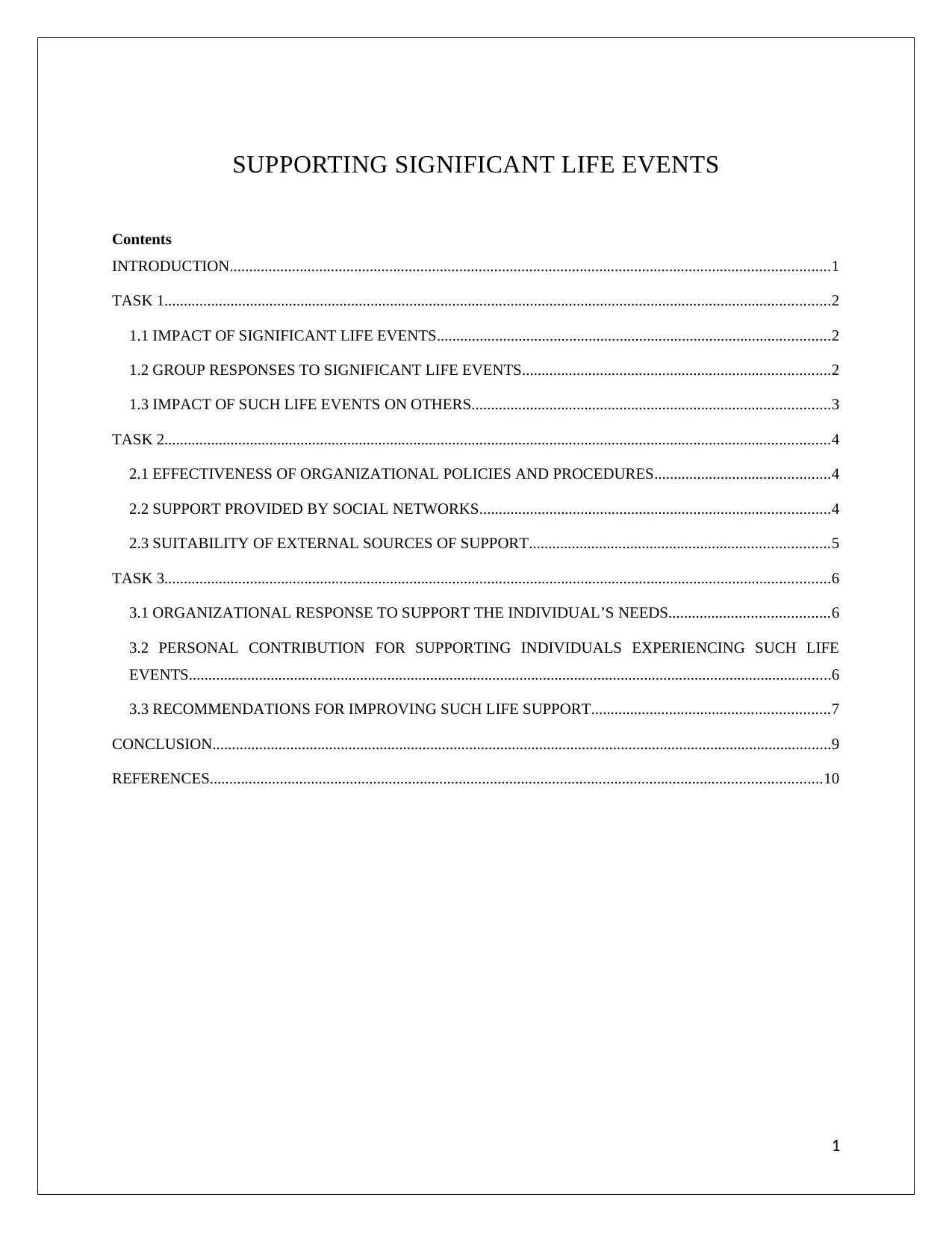
SUPPORTING SIGNIFICANT LIFE EVENTS
Contents
INTRODUCTION..........................................................................................................................................................1
TASK 1...........................................................................................................................................................................2
1.1 IMPACT OF SIGNIFICANT LIFE EVENTS.....................................................................................................2
1.2 GROUP RESPONSES TO SIGNIFICANT LIFE EVENTS...............................................................................2
1.3 IMPACT OF SUCH LIFE EVENTS ON OTHERS............................................................................................3
TASK 2...........................................................................................................................................................................4
2.1 EFFECTIVENESS OF ORGANIZATIONAL POLICIES AND PROCEDURES.............................................4
2.2 SUPPORT PROVIDED BY SOCIAL NETWORKS..........................................................................................4
2.3 SUITABILITY OF EXTERNAL SOURCES OF SUPPORT.............................................................................5
TASK 3...........................................................................................................................................................................6
3.1 ORGANIZATIONAL RESPONSE TO SUPPORT THE INDIVIDUAL’S NEEDS.........................................6
3.2 PERSONAL CONTRIBUTION FOR SUPPORTING INDIVIDUALS EXPERIENCING SUCH LIFE
EVENTS.....................................................................................................................................................................6
3.3 RECOMMENDATIONS FOR IMPROVING SUCH LIFE SUPPORT.............................................................7
CONCLUSION...............................................................................................................................................................9
REFERENCES.............................................................................................................................................................10
1
Contents
INTRODUCTION..........................................................................................................................................................1
TASK 1...........................................................................................................................................................................2
1.1 IMPACT OF SIGNIFICANT LIFE EVENTS.....................................................................................................2
1.2 GROUP RESPONSES TO SIGNIFICANT LIFE EVENTS...............................................................................2
1.3 IMPACT OF SUCH LIFE EVENTS ON OTHERS............................................................................................3
TASK 2...........................................................................................................................................................................4
2.1 EFFECTIVENESS OF ORGANIZATIONAL POLICIES AND PROCEDURES.............................................4
2.2 SUPPORT PROVIDED BY SOCIAL NETWORKS..........................................................................................4
2.3 SUITABILITY OF EXTERNAL SOURCES OF SUPPORT.............................................................................5
TASK 3...........................................................................................................................................................................6
3.1 ORGANIZATIONAL RESPONSE TO SUPPORT THE INDIVIDUAL’S NEEDS.........................................6
3.2 PERSONAL CONTRIBUTION FOR SUPPORTING INDIVIDUALS EXPERIENCING SUCH LIFE
EVENTS.....................................................................................................................................................................6
3.3 RECOMMENDATIONS FOR IMPROVING SUCH LIFE SUPPORT.............................................................7
CONCLUSION...............................................................................................................................................................9
REFERENCES.............................................................................................................................................................10
1
Paraphrase This Document
Need a fresh take? Get an instant paraphrase of this document with our AI Paraphraser
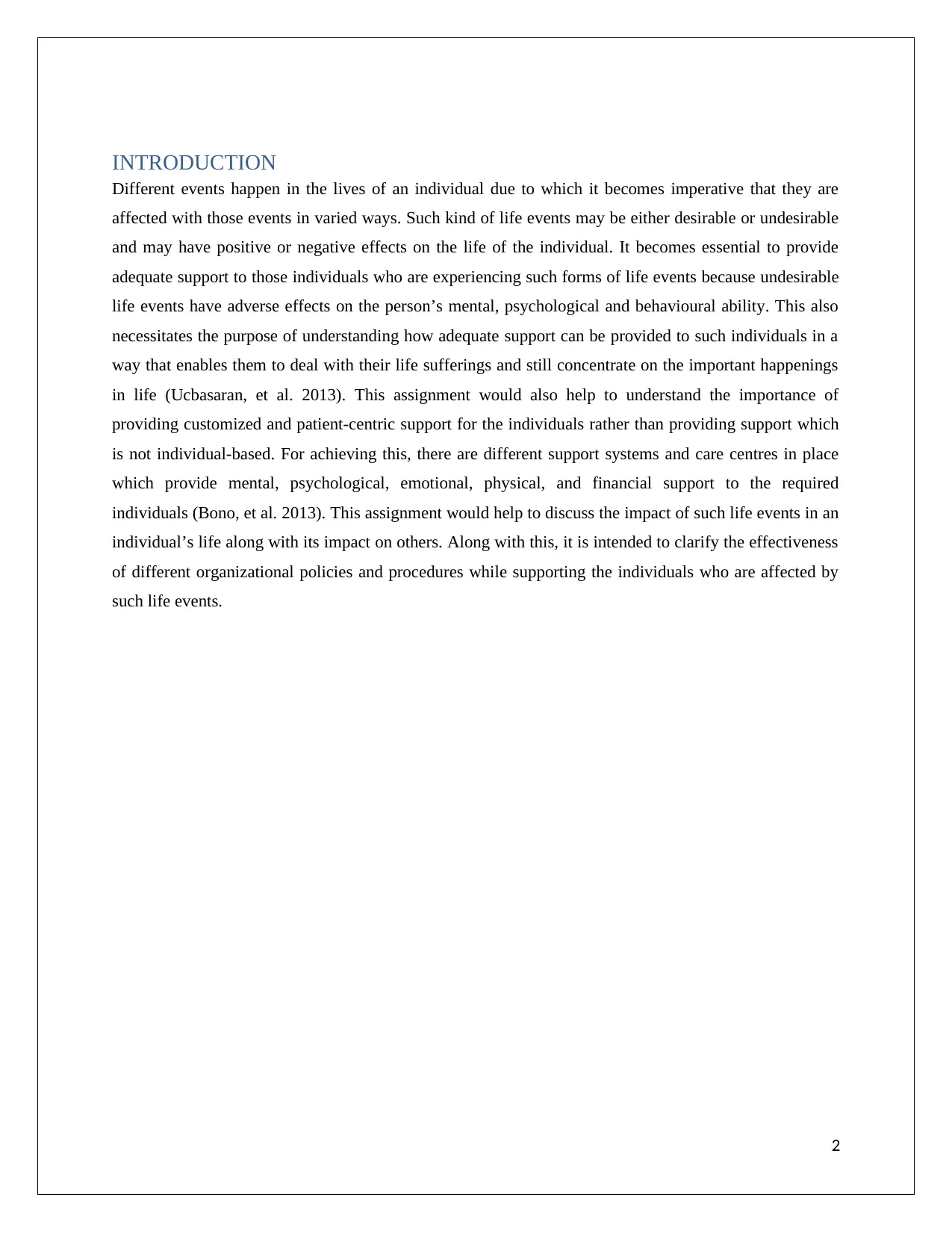
INTRODUCTION
Different events happen in the lives of an individual due to which it becomes imperative that they are
affected with those events in varied ways. Such kind of life events may be either desirable or undesirable
and may have positive or negative effects on the life of the individual. It becomes essential to provide
adequate support to those individuals who are experiencing such forms of life events because undesirable
life events have adverse effects on the person’s mental, psychological and behavioural ability. This also
necessitates the purpose of understanding how adequate support can be provided to such individuals in a
way that enables them to deal with their life sufferings and still concentrate on the important happenings
in life (Ucbasaran, et al. 2013). This assignment would also help to understand the importance of
providing customized and patient-centric support for the individuals rather than providing support which
is not individual-based. For achieving this, there are different support systems and care centres in place
which provide mental, psychological, emotional, physical, and financial support to the required
individuals (Bono, et al. 2013). This assignment would help to discuss the impact of such life events in an
individual’s life along with its impact on others. Along with this, it is intended to clarify the effectiveness
of different organizational policies and procedures while supporting the individuals who are affected by
such life events.
2
Different events happen in the lives of an individual due to which it becomes imperative that they are
affected with those events in varied ways. Such kind of life events may be either desirable or undesirable
and may have positive or negative effects on the life of the individual. It becomes essential to provide
adequate support to those individuals who are experiencing such forms of life events because undesirable
life events have adverse effects on the person’s mental, psychological and behavioural ability. This also
necessitates the purpose of understanding how adequate support can be provided to such individuals in a
way that enables them to deal with their life sufferings and still concentrate on the important happenings
in life (Ucbasaran, et al. 2013). This assignment would also help to understand the importance of
providing customized and patient-centric support for the individuals rather than providing support which
is not individual-based. For achieving this, there are different support systems and care centres in place
which provide mental, psychological, emotional, physical, and financial support to the required
individuals (Bono, et al. 2013). This assignment would help to discuss the impact of such life events in an
individual’s life along with its impact on others. Along with this, it is intended to clarify the effectiveness
of different organizational policies and procedures while supporting the individuals who are affected by
such life events.
2
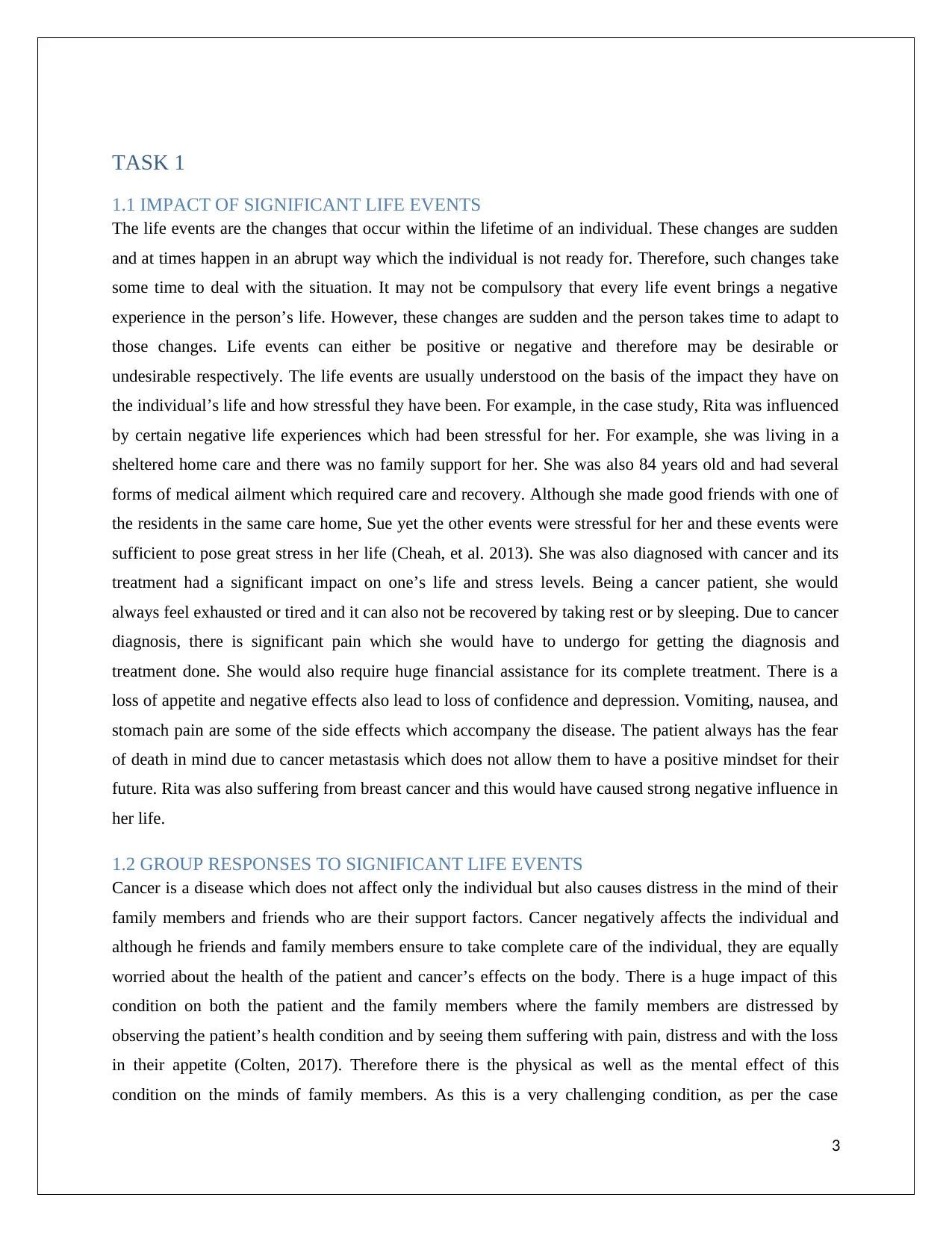
TASK 1
1.1 IMPACT OF SIGNIFICANT LIFE EVENTS
The life events are the changes that occur within the lifetime of an individual. These changes are sudden
and at times happen in an abrupt way which the individual is not ready for. Therefore, such changes take
some time to deal with the situation. It may not be compulsory that every life event brings a negative
experience in the person’s life. However, these changes are sudden and the person takes time to adapt to
those changes. Life events can either be positive or negative and therefore may be desirable or
undesirable respectively. The life events are usually understood on the basis of the impact they have on
the individual’s life and how stressful they have been. For example, in the case study, Rita was influenced
by certain negative life experiences which had been stressful for her. For example, she was living in a
sheltered home care and there was no family support for her. She was also 84 years old and had several
forms of medical ailment which required care and recovery. Although she made good friends with one of
the residents in the same care home, Sue yet the other events were stressful for her and these events were
sufficient to pose great stress in her life (Cheah, et al. 2013). She was also diagnosed with cancer and its
treatment had a significant impact on one’s life and stress levels. Being a cancer patient, she would
always feel exhausted or tired and it can also not be recovered by taking rest or by sleeping. Due to cancer
diagnosis, there is significant pain which she would have to undergo for getting the diagnosis and
treatment done. She would also require huge financial assistance for its complete treatment. There is a
loss of appetite and negative effects also lead to loss of confidence and depression. Vomiting, nausea, and
stomach pain are some of the side effects which accompany the disease. The patient always has the fear
of death in mind due to cancer metastasis which does not allow them to have a positive mindset for their
future. Rita was also suffering from breast cancer and this would have caused strong negative influence in
her life.
1.2 GROUP RESPONSES TO SIGNIFICANT LIFE EVENTS
Cancer is a disease which does not affect only the individual but also causes distress in the mind of their
family members and friends who are their support factors. Cancer negatively affects the individual and
although he friends and family members ensure to take complete care of the individual, they are equally
worried about the health of the patient and cancer’s effects on the body. There is a huge impact of this
condition on both the patient and the family members where the family members are distressed by
observing the patient’s health condition and by seeing them suffering with pain, distress and with the loss
in their appetite (Colten, 2017). Therefore there is the physical as well as the mental effect of this
condition on the minds of family members. As this is a very challenging condition, as per the case
3
1.1 IMPACT OF SIGNIFICANT LIFE EVENTS
The life events are the changes that occur within the lifetime of an individual. These changes are sudden
and at times happen in an abrupt way which the individual is not ready for. Therefore, such changes take
some time to deal with the situation. It may not be compulsory that every life event brings a negative
experience in the person’s life. However, these changes are sudden and the person takes time to adapt to
those changes. Life events can either be positive or negative and therefore may be desirable or
undesirable respectively. The life events are usually understood on the basis of the impact they have on
the individual’s life and how stressful they have been. For example, in the case study, Rita was influenced
by certain negative life experiences which had been stressful for her. For example, she was living in a
sheltered home care and there was no family support for her. She was also 84 years old and had several
forms of medical ailment which required care and recovery. Although she made good friends with one of
the residents in the same care home, Sue yet the other events were stressful for her and these events were
sufficient to pose great stress in her life (Cheah, et al. 2013). She was also diagnosed with cancer and its
treatment had a significant impact on one’s life and stress levels. Being a cancer patient, she would
always feel exhausted or tired and it can also not be recovered by taking rest or by sleeping. Due to cancer
diagnosis, there is significant pain which she would have to undergo for getting the diagnosis and
treatment done. She would also require huge financial assistance for its complete treatment. There is a
loss of appetite and negative effects also lead to loss of confidence and depression. Vomiting, nausea, and
stomach pain are some of the side effects which accompany the disease. The patient always has the fear
of death in mind due to cancer metastasis which does not allow them to have a positive mindset for their
future. Rita was also suffering from breast cancer and this would have caused strong negative influence in
her life.
1.2 GROUP RESPONSES TO SIGNIFICANT LIFE EVENTS
Cancer is a disease which does not affect only the individual but also causes distress in the mind of their
family members and friends who are their support factors. Cancer negatively affects the individual and
although he friends and family members ensure to take complete care of the individual, they are equally
worried about the health of the patient and cancer’s effects on the body. There is a huge impact of this
condition on both the patient and the family members where the family members are distressed by
observing the patient’s health condition and by seeing them suffering with pain, distress and with the loss
in their appetite (Colten, 2017). Therefore there is the physical as well as the mental effect of this
condition on the minds of family members. As this is a very challenging condition, as per the case
3
⊘ This is a preview!⊘
Do you want full access?
Subscribe today to unlock all pages.

Trusted by 1+ million students worldwide
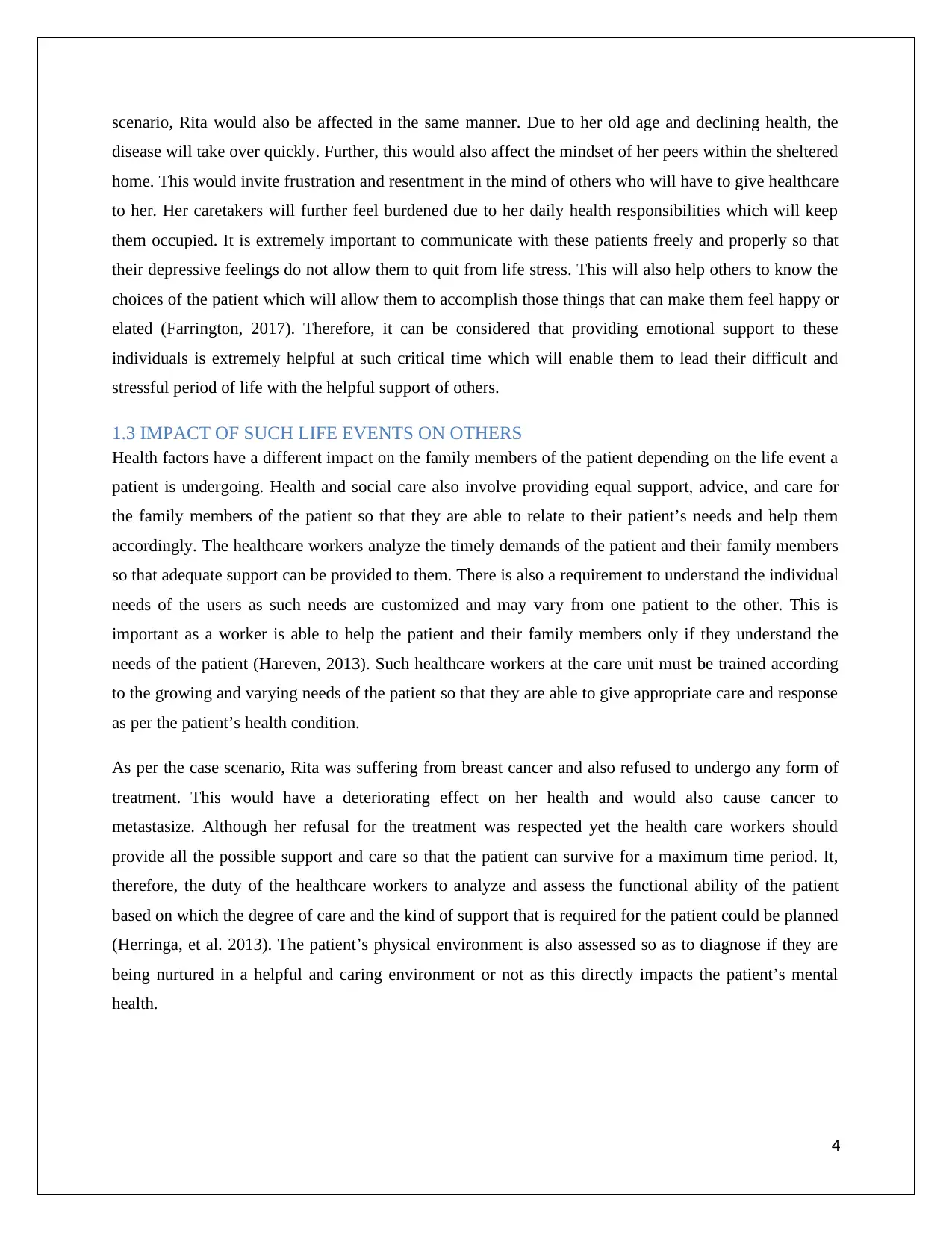
scenario, Rita would also be affected in the same manner. Due to her old age and declining health, the
disease will take over quickly. Further, this would also affect the mindset of her peers within the sheltered
home. This would invite frustration and resentment in the mind of others who will have to give healthcare
to her. Her caretakers will further feel burdened due to her daily health responsibilities which will keep
them occupied. It is extremely important to communicate with these patients freely and properly so that
their depressive feelings do not allow them to quit from life stress. This will also help others to know the
choices of the patient which will allow them to accomplish those things that can make them feel happy or
elated (Farrington, 2017). Therefore, it can be considered that providing emotional support to these
individuals is extremely helpful at such critical time which will enable them to lead their difficult and
stressful period of life with the helpful support of others.
1.3 IMPACT OF SUCH LIFE EVENTS ON OTHERS
Health factors have a different impact on the family members of the patient depending on the life event a
patient is undergoing. Health and social care also involve providing equal support, advice, and care for
the family members of the patient so that they are able to relate to their patient’s needs and help them
accordingly. The healthcare workers analyze the timely demands of the patient and their family members
so that adequate support can be provided to them. There is also a requirement to understand the individual
needs of the users as such needs are customized and may vary from one patient to the other. This is
important as a worker is able to help the patient and their family members only if they understand the
needs of the patient (Hareven, 2013). Such healthcare workers at the care unit must be trained according
to the growing and varying needs of the patient so that they are able to give appropriate care and response
as per the patient’s health condition.
As per the case scenario, Rita was suffering from breast cancer and also refused to undergo any form of
treatment. This would have a deteriorating effect on her health and would also cause cancer to
metastasize. Although her refusal for the treatment was respected yet the health care workers should
provide all the possible support and care so that the patient can survive for a maximum time period. It,
therefore, the duty of the healthcare workers to analyze and assess the functional ability of the patient
based on which the degree of care and the kind of support that is required for the patient could be planned
(Herringa, et al. 2013). The patient’s physical environment is also assessed so as to diagnose if they are
being nurtured in a helpful and caring environment or not as this directly impacts the patient’s mental
health.
4
disease will take over quickly. Further, this would also affect the mindset of her peers within the sheltered
home. This would invite frustration and resentment in the mind of others who will have to give healthcare
to her. Her caretakers will further feel burdened due to her daily health responsibilities which will keep
them occupied. It is extremely important to communicate with these patients freely and properly so that
their depressive feelings do not allow them to quit from life stress. This will also help others to know the
choices of the patient which will allow them to accomplish those things that can make them feel happy or
elated (Farrington, 2017). Therefore, it can be considered that providing emotional support to these
individuals is extremely helpful at such critical time which will enable them to lead their difficult and
stressful period of life with the helpful support of others.
1.3 IMPACT OF SUCH LIFE EVENTS ON OTHERS
Health factors have a different impact on the family members of the patient depending on the life event a
patient is undergoing. Health and social care also involve providing equal support, advice, and care for
the family members of the patient so that they are able to relate to their patient’s needs and help them
accordingly. The healthcare workers analyze the timely demands of the patient and their family members
so that adequate support can be provided to them. There is also a requirement to understand the individual
needs of the users as such needs are customized and may vary from one patient to the other. This is
important as a worker is able to help the patient and their family members only if they understand the
needs of the patient (Hareven, 2013). Such healthcare workers at the care unit must be trained according
to the growing and varying needs of the patient so that they are able to give appropriate care and response
as per the patient’s health condition.
As per the case scenario, Rita was suffering from breast cancer and also refused to undergo any form of
treatment. This would have a deteriorating effect on her health and would also cause cancer to
metastasize. Although her refusal for the treatment was respected yet the health care workers should
provide all the possible support and care so that the patient can survive for a maximum time period. It,
therefore, the duty of the healthcare workers to analyze and assess the functional ability of the patient
based on which the degree of care and the kind of support that is required for the patient could be planned
(Herringa, et al. 2013). The patient’s physical environment is also assessed so as to diagnose if they are
being nurtured in a helpful and caring environment or not as this directly impacts the patient’s mental
health.
4
Paraphrase This Document
Need a fresh take? Get an instant paraphrase of this document with our AI Paraphraser
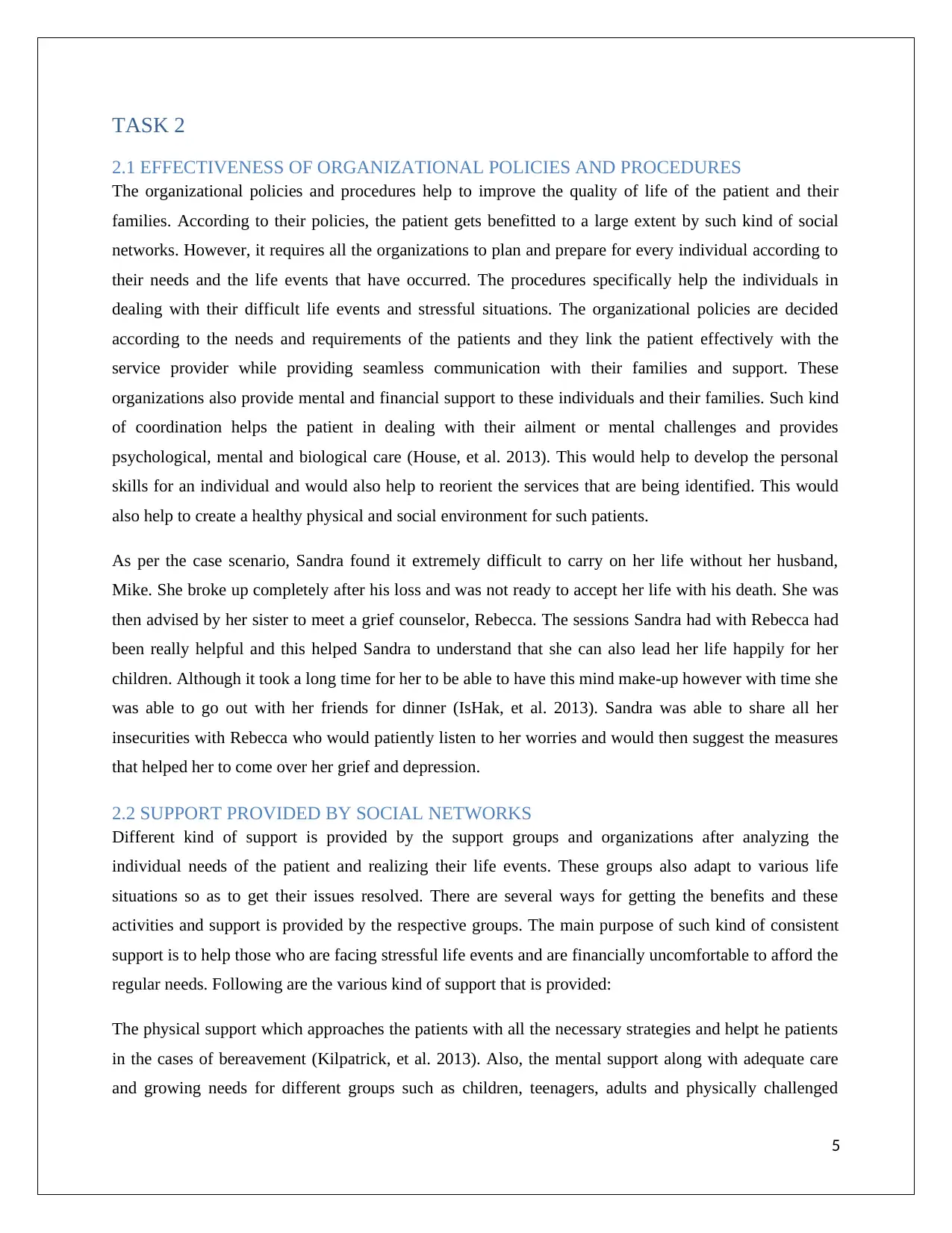
TASK 2
2.1 EFFECTIVENESS OF ORGANIZATIONAL POLICIES AND PROCEDURES
The organizational policies and procedures help to improve the quality of life of the patient and their
families. According to their policies, the patient gets benefitted to a large extent by such kind of social
networks. However, it requires all the organizations to plan and prepare for every individual according to
their needs and the life events that have occurred. The procedures specifically help the individuals in
dealing with their difficult life events and stressful situations. The organizational policies are decided
according to the needs and requirements of the patients and they link the patient effectively with the
service provider while providing seamless communication with their families and support. These
organizations also provide mental and financial support to these individuals and their families. Such kind
of coordination helps the patient in dealing with their ailment or mental challenges and provides
psychological, mental and biological care (House, et al. 2013). This would help to develop the personal
skills for an individual and would also help to reorient the services that are being identified. This would
also help to create a healthy physical and social environment for such patients.
As per the case scenario, Sandra found it extremely difficult to carry on her life without her husband,
Mike. She broke up completely after his loss and was not ready to accept her life with his death. She was
then advised by her sister to meet a grief counselor, Rebecca. The sessions Sandra had with Rebecca had
been really helpful and this helped Sandra to understand that she can also lead her life happily for her
children. Although it took a long time for her to be able to have this mind make-up however with time she
was able to go out with her friends for dinner (IsHak, et al. 2013). Sandra was able to share all her
insecurities with Rebecca who would patiently listen to her worries and would then suggest the measures
that helped her to come over her grief and depression.
2.2 SUPPORT PROVIDED BY SOCIAL NETWORKS
Different kind of support is provided by the support groups and organizations after analyzing the
individual needs of the patient and realizing their life events. These groups also adapt to various life
situations so as to get their issues resolved. There are several ways for getting the benefits and these
activities and support is provided by the respective groups. The main purpose of such kind of consistent
support is to help those who are facing stressful life events and are financially uncomfortable to afford the
regular needs. Following are the various kind of support that is provided:
The physical support which approaches the patients with all the necessary strategies and helpt he patients
in the cases of bereavement (Kilpatrick, et al. 2013). Also, the mental support along with adequate care
and growing needs for different groups such as children, teenagers, adults and physically challenged
5
2.1 EFFECTIVENESS OF ORGANIZATIONAL POLICIES AND PROCEDURES
The organizational policies and procedures help to improve the quality of life of the patient and their
families. According to their policies, the patient gets benefitted to a large extent by such kind of social
networks. However, it requires all the organizations to plan and prepare for every individual according to
their needs and the life events that have occurred. The procedures specifically help the individuals in
dealing with their difficult life events and stressful situations. The organizational policies are decided
according to the needs and requirements of the patients and they link the patient effectively with the
service provider while providing seamless communication with their families and support. These
organizations also provide mental and financial support to these individuals and their families. Such kind
of coordination helps the patient in dealing with their ailment or mental challenges and provides
psychological, mental and biological care (House, et al. 2013). This would help to develop the personal
skills for an individual and would also help to reorient the services that are being identified. This would
also help to create a healthy physical and social environment for such patients.
As per the case scenario, Sandra found it extremely difficult to carry on her life without her husband,
Mike. She broke up completely after his loss and was not ready to accept her life with his death. She was
then advised by her sister to meet a grief counselor, Rebecca. The sessions Sandra had with Rebecca had
been really helpful and this helped Sandra to understand that she can also lead her life happily for her
children. Although it took a long time for her to be able to have this mind make-up however with time she
was able to go out with her friends for dinner (IsHak, et al. 2013). Sandra was able to share all her
insecurities with Rebecca who would patiently listen to her worries and would then suggest the measures
that helped her to come over her grief and depression.
2.2 SUPPORT PROVIDED BY SOCIAL NETWORKS
Different kind of support is provided by the support groups and organizations after analyzing the
individual needs of the patient and realizing their life events. These groups also adapt to various life
situations so as to get their issues resolved. There are several ways for getting the benefits and these
activities and support is provided by the respective groups. The main purpose of such kind of consistent
support is to help those who are facing stressful life events and are financially uncomfortable to afford the
regular needs. Following are the various kind of support that is provided:
The physical support which approaches the patients with all the necessary strategies and helpt he patients
in the cases of bereavement (Kilpatrick, et al. 2013). Also, the mental support along with adequate care
and growing needs for different groups such as children, teenagers, adults and physically challenged
5
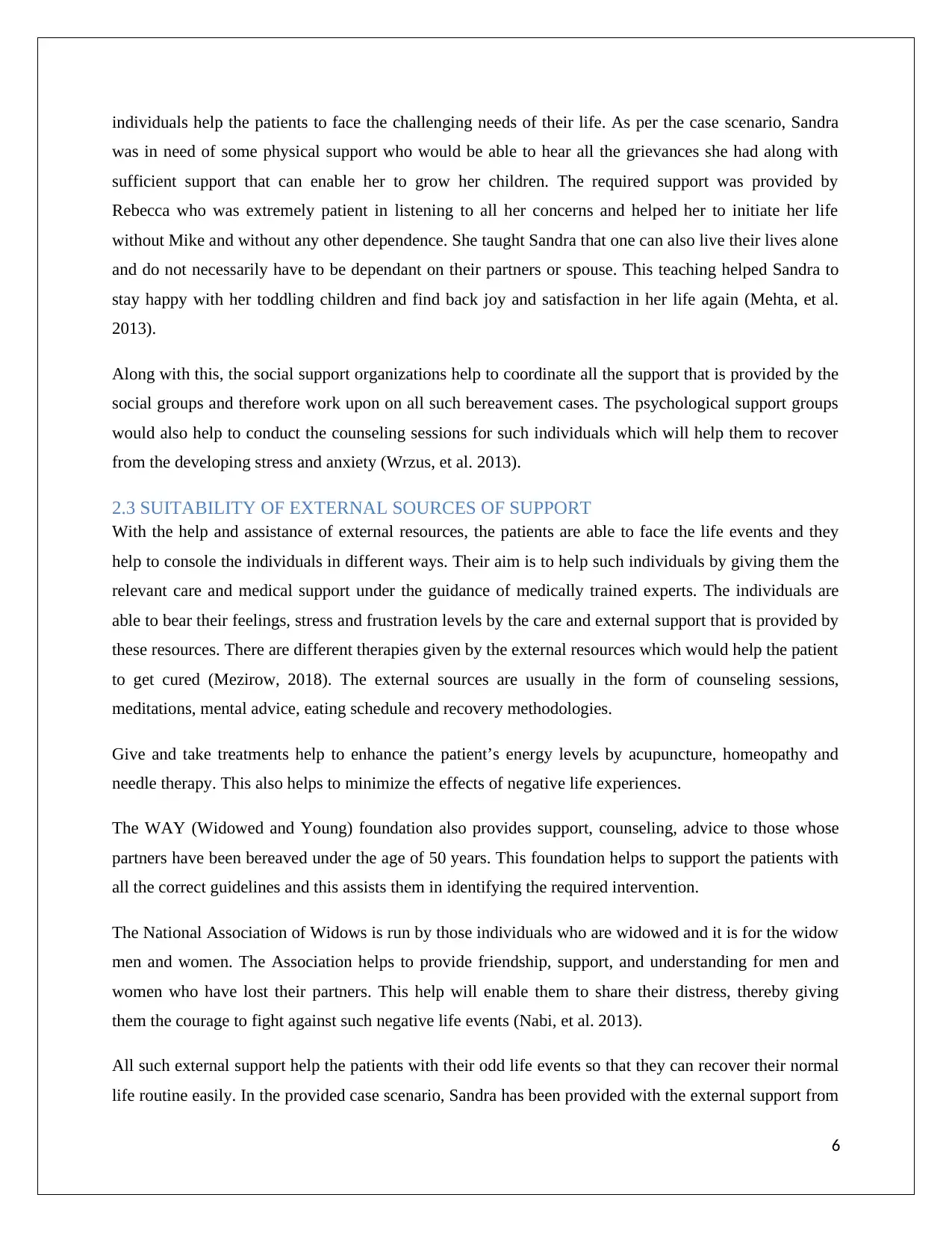
individuals help the patients to face the challenging needs of their life. As per the case scenario, Sandra
was in need of some physical support who would be able to hear all the grievances she had along with
sufficient support that can enable her to grow her children. The required support was provided by
Rebecca who was extremely patient in listening to all her concerns and helped her to initiate her life
without Mike and without any other dependence. She taught Sandra that one can also live their lives alone
and do not necessarily have to be dependant on their partners or spouse. This teaching helped Sandra to
stay happy with her toddling children and find back joy and satisfaction in her life again (Mehta, et al.
2013).
Along with this, the social support organizations help to coordinate all the support that is provided by the
social groups and therefore work upon on all such bereavement cases. The psychological support groups
would also help to conduct the counseling sessions for such individuals which will help them to recover
from the developing stress and anxiety (Wrzus, et al. 2013).
2.3 SUITABILITY OF EXTERNAL SOURCES OF SUPPORT
With the help and assistance of external resources, the patients are able to face the life events and they
help to console the individuals in different ways. Their aim is to help such individuals by giving them the
relevant care and medical support under the guidance of medically trained experts. The individuals are
able to bear their feelings, stress and frustration levels by the care and external support that is provided by
these resources. There are different therapies given by the external resources which would help the patient
to get cured (Mezirow, 2018). The external sources are usually in the form of counseling sessions,
meditations, mental advice, eating schedule and recovery methodologies.
Give and take treatments help to enhance the patient’s energy levels by acupuncture, homeopathy and
needle therapy. This also helps to minimize the effects of negative life experiences.
The WAY (Widowed and Young) foundation also provides support, counseling, advice to those whose
partners have been bereaved under the age of 50 years. This foundation helps to support the patients with
all the correct guidelines and this assists them in identifying the required intervention.
The National Association of Widows is run by those individuals who are widowed and it is for the widow
men and women. The Association helps to provide friendship, support, and understanding for men and
women who have lost their partners. This help will enable them to share their distress, thereby giving
them the courage to fight against such negative life events (Nabi, et al. 2013).
All such external support help the patients with their odd life events so that they can recover their normal
life routine easily. In the provided case scenario, Sandra has been provided with the external support from
6
was in need of some physical support who would be able to hear all the grievances she had along with
sufficient support that can enable her to grow her children. The required support was provided by
Rebecca who was extremely patient in listening to all her concerns and helped her to initiate her life
without Mike and without any other dependence. She taught Sandra that one can also live their lives alone
and do not necessarily have to be dependant on their partners or spouse. This teaching helped Sandra to
stay happy with her toddling children and find back joy and satisfaction in her life again (Mehta, et al.
2013).
Along with this, the social support organizations help to coordinate all the support that is provided by the
social groups and therefore work upon on all such bereavement cases. The psychological support groups
would also help to conduct the counseling sessions for such individuals which will help them to recover
from the developing stress and anxiety (Wrzus, et al. 2013).
2.3 SUITABILITY OF EXTERNAL SOURCES OF SUPPORT
With the help and assistance of external resources, the patients are able to face the life events and they
help to console the individuals in different ways. Their aim is to help such individuals by giving them the
relevant care and medical support under the guidance of medically trained experts. The individuals are
able to bear their feelings, stress and frustration levels by the care and external support that is provided by
these resources. There are different therapies given by the external resources which would help the patient
to get cured (Mezirow, 2018). The external sources are usually in the form of counseling sessions,
meditations, mental advice, eating schedule and recovery methodologies.
Give and take treatments help to enhance the patient’s energy levels by acupuncture, homeopathy and
needle therapy. This also helps to minimize the effects of negative life experiences.
The WAY (Widowed and Young) foundation also provides support, counseling, advice to those whose
partners have been bereaved under the age of 50 years. This foundation helps to support the patients with
all the correct guidelines and this assists them in identifying the required intervention.
The National Association of Widows is run by those individuals who are widowed and it is for the widow
men and women. The Association helps to provide friendship, support, and understanding for men and
women who have lost their partners. This help will enable them to share their distress, thereby giving
them the courage to fight against such negative life events (Nabi, et al. 2013).
All such external support help the patients with their odd life events so that they can recover their normal
life routine easily. In the provided case scenario, Sandra has been provided with the external support from
6
⊘ This is a preview!⊘
Do you want full access?
Subscribe today to unlock all pages.

Trusted by 1+ million students worldwide
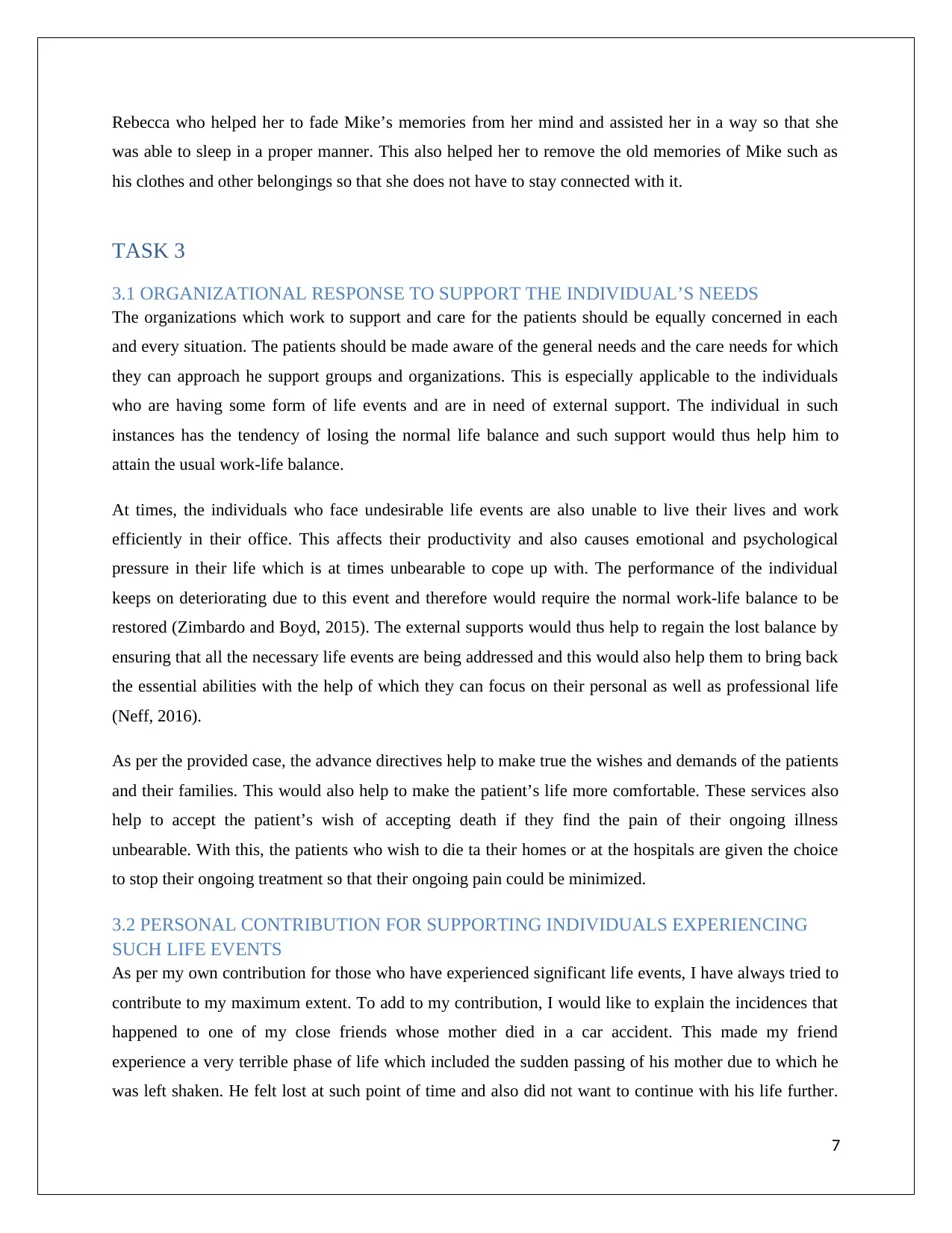
Rebecca who helped her to fade Mike’s memories from her mind and assisted her in a way so that she
was able to sleep in a proper manner. This also helped her to remove the old memories of Mike such as
his clothes and other belongings so that she does not have to stay connected with it.
TASK 3
3.1 ORGANIZATIONAL RESPONSE TO SUPPORT THE INDIVIDUAL’S NEEDS
The organizations which work to support and care for the patients should be equally concerned in each
and every situation. The patients should be made aware of the general needs and the care needs for which
they can approach he support groups and organizations. This is especially applicable to the individuals
who are having some form of life events and are in need of external support. The individual in such
instances has the tendency of losing the normal life balance and such support would thus help him to
attain the usual work-life balance.
At times, the individuals who face undesirable life events are also unable to live their lives and work
efficiently in their office. This affects their productivity and also causes emotional and psychological
pressure in their life which is at times unbearable to cope up with. The performance of the individual
keeps on deteriorating due to this event and therefore would require the normal work-life balance to be
restored (Zimbardo and Boyd, 2015). The external supports would thus help to regain the lost balance by
ensuring that all the necessary life events are being addressed and this would also help them to bring back
the essential abilities with the help of which they can focus on their personal as well as professional life
(Neff, 2016).
As per the provided case, the advance directives help to make true the wishes and demands of the patients
and their families. This would also help to make the patient’s life more comfortable. These services also
help to accept the patient’s wish of accepting death if they find the pain of their ongoing illness
unbearable. With this, the patients who wish to die ta their homes or at the hospitals are given the choice
to stop their ongoing treatment so that their ongoing pain could be minimized.
3.2 PERSONAL CONTRIBUTION FOR SUPPORTING INDIVIDUALS EXPERIENCING
SUCH LIFE EVENTS
As per my own contribution for those who have experienced significant life events, I have always tried to
contribute to my maximum extent. To add to my contribution, I would like to explain the incidences that
happened to one of my close friends whose mother died in a car accident. This made my friend
experience a very terrible phase of life which included the sudden passing of his mother due to which he
was left shaken. He felt lost at such point of time and also did not want to continue with his life further.
7
was able to sleep in a proper manner. This also helped her to remove the old memories of Mike such as
his clothes and other belongings so that she does not have to stay connected with it.
TASK 3
3.1 ORGANIZATIONAL RESPONSE TO SUPPORT THE INDIVIDUAL’S NEEDS
The organizations which work to support and care for the patients should be equally concerned in each
and every situation. The patients should be made aware of the general needs and the care needs for which
they can approach he support groups and organizations. This is especially applicable to the individuals
who are having some form of life events and are in need of external support. The individual in such
instances has the tendency of losing the normal life balance and such support would thus help him to
attain the usual work-life balance.
At times, the individuals who face undesirable life events are also unable to live their lives and work
efficiently in their office. This affects their productivity and also causes emotional and psychological
pressure in their life which is at times unbearable to cope up with. The performance of the individual
keeps on deteriorating due to this event and therefore would require the normal work-life balance to be
restored (Zimbardo and Boyd, 2015). The external supports would thus help to regain the lost balance by
ensuring that all the necessary life events are being addressed and this would also help them to bring back
the essential abilities with the help of which they can focus on their personal as well as professional life
(Neff, 2016).
As per the provided case, the advance directives help to make true the wishes and demands of the patients
and their families. This would also help to make the patient’s life more comfortable. These services also
help to accept the patient’s wish of accepting death if they find the pain of their ongoing illness
unbearable. With this, the patients who wish to die ta their homes or at the hospitals are given the choice
to stop their ongoing treatment so that their ongoing pain could be minimized.
3.2 PERSONAL CONTRIBUTION FOR SUPPORTING INDIVIDUALS EXPERIENCING
SUCH LIFE EVENTS
As per my own contribution for those who have experienced significant life events, I have always tried to
contribute to my maximum extent. To add to my contribution, I would like to explain the incidences that
happened to one of my close friends whose mother died in a car accident. This made my friend
experience a very terrible phase of life which included the sudden passing of his mother due to which he
was left shaken. He felt lost at such point of time and also did not want to continue with his life further.
7
Paraphrase This Document
Need a fresh take? Get an instant paraphrase of this document with our AI Paraphraser
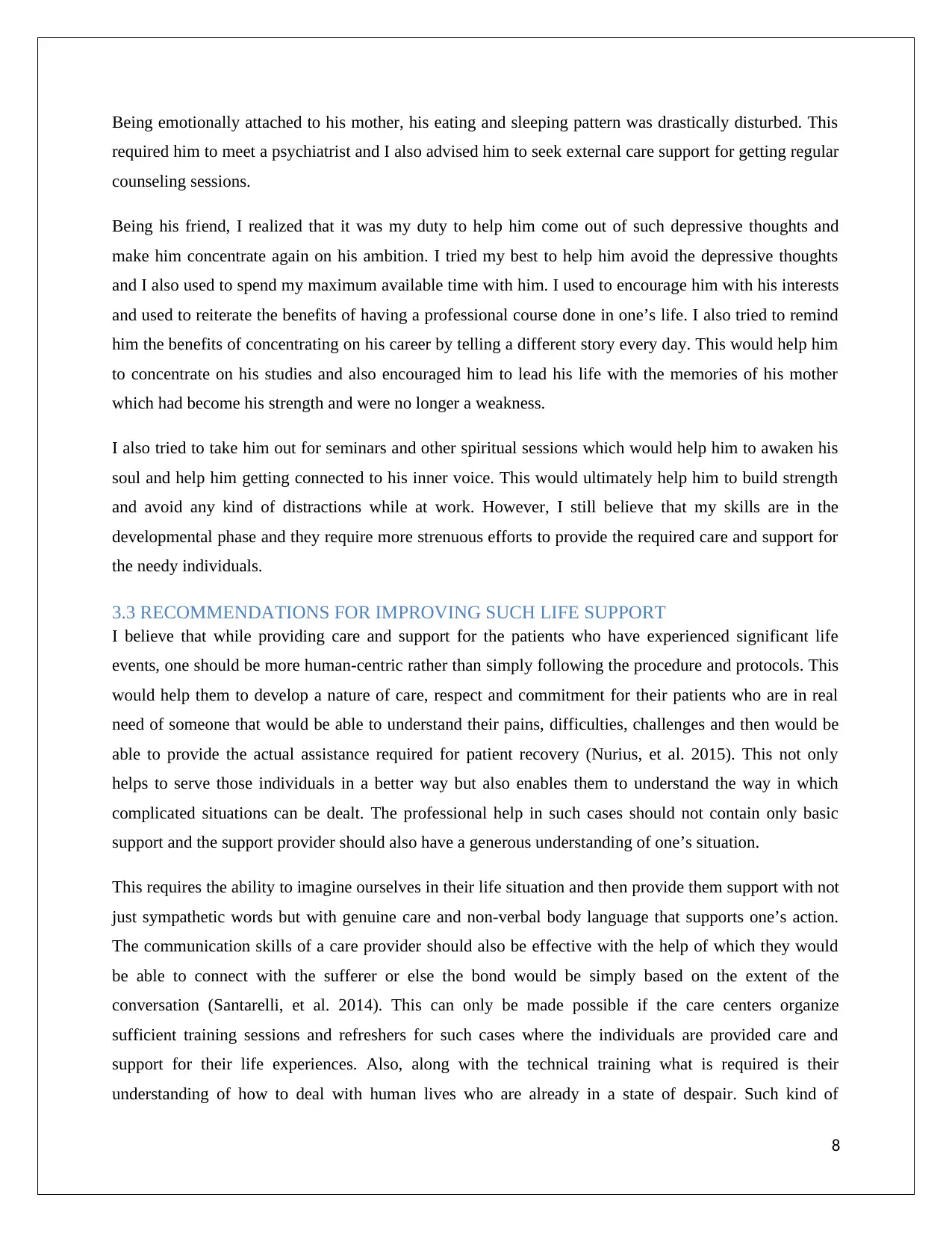
Being emotionally attached to his mother, his eating and sleeping pattern was drastically disturbed. This
required him to meet a psychiatrist and I also advised him to seek external care support for getting regular
counseling sessions.
Being his friend, I realized that it was my duty to help him come out of such depressive thoughts and
make him concentrate again on his ambition. I tried my best to help him avoid the depressive thoughts
and I also used to spend my maximum available time with him. I used to encourage him with his interests
and used to reiterate the benefits of having a professional course done in one’s life. I also tried to remind
him the benefits of concentrating on his career by telling a different story every day. This would help him
to concentrate on his studies and also encouraged him to lead his life with the memories of his mother
which had become his strength and were no longer a weakness.
I also tried to take him out for seminars and other spiritual sessions which would help him to awaken his
soul and help him getting connected to his inner voice. This would ultimately help him to build strength
and avoid any kind of distractions while at work. However, I still believe that my skills are in the
developmental phase and they require more strenuous efforts to provide the required care and support for
the needy individuals.
3.3 RECOMMENDATIONS FOR IMPROVING SUCH LIFE SUPPORT
I believe that while providing care and support for the patients who have experienced significant life
events, one should be more human-centric rather than simply following the procedure and protocols. This
would help them to develop a nature of care, respect and commitment for their patients who are in real
need of someone that would be able to understand their pains, difficulties, challenges and then would be
able to provide the actual assistance required for patient recovery (Nurius, et al. 2015). This not only
helps to serve those individuals in a better way but also enables them to understand the way in which
complicated situations can be dealt. The professional help in such cases should not contain only basic
support and the support provider should also have a generous understanding of one’s situation.
This requires the ability to imagine ourselves in their life situation and then provide them support with not
just sympathetic words but with genuine care and non-verbal body language that supports one’s action.
The communication skills of a care provider should also be effective with the help of which they would
be able to connect with the sufferer or else the bond would be simply based on the extent of the
conversation (Santarelli, et al. 2014). This can only be made possible if the care centers organize
sufficient training sessions and refreshers for such cases where the individuals are provided care and
support for their life experiences. Also, along with the technical training what is required is their
understanding of how to deal with human lives who are already in a state of despair. Such kind of
8
required him to meet a psychiatrist and I also advised him to seek external care support for getting regular
counseling sessions.
Being his friend, I realized that it was my duty to help him come out of such depressive thoughts and
make him concentrate again on his ambition. I tried my best to help him avoid the depressive thoughts
and I also used to spend my maximum available time with him. I used to encourage him with his interests
and used to reiterate the benefits of having a professional course done in one’s life. I also tried to remind
him the benefits of concentrating on his career by telling a different story every day. This would help him
to concentrate on his studies and also encouraged him to lead his life with the memories of his mother
which had become his strength and were no longer a weakness.
I also tried to take him out for seminars and other spiritual sessions which would help him to awaken his
soul and help him getting connected to his inner voice. This would ultimately help him to build strength
and avoid any kind of distractions while at work. However, I still believe that my skills are in the
developmental phase and they require more strenuous efforts to provide the required care and support for
the needy individuals.
3.3 RECOMMENDATIONS FOR IMPROVING SUCH LIFE SUPPORT
I believe that while providing care and support for the patients who have experienced significant life
events, one should be more human-centric rather than simply following the procedure and protocols. This
would help them to develop a nature of care, respect and commitment for their patients who are in real
need of someone that would be able to understand their pains, difficulties, challenges and then would be
able to provide the actual assistance required for patient recovery (Nurius, et al. 2015). This not only
helps to serve those individuals in a better way but also enables them to understand the way in which
complicated situations can be dealt. The professional help in such cases should not contain only basic
support and the support provider should also have a generous understanding of one’s situation.
This requires the ability to imagine ourselves in their life situation and then provide them support with not
just sympathetic words but with genuine care and non-verbal body language that supports one’s action.
The communication skills of a care provider should also be effective with the help of which they would
be able to connect with the sufferer or else the bond would be simply based on the extent of the
conversation (Santarelli, et al. 2014). This can only be made possible if the care centers organize
sufficient training sessions and refreshers for such cases where the individuals are provided care and
support for their life experiences. Also, along with the technical training what is required is their
understanding of how to deal with human lives who are already in a state of despair. Such kind of
8
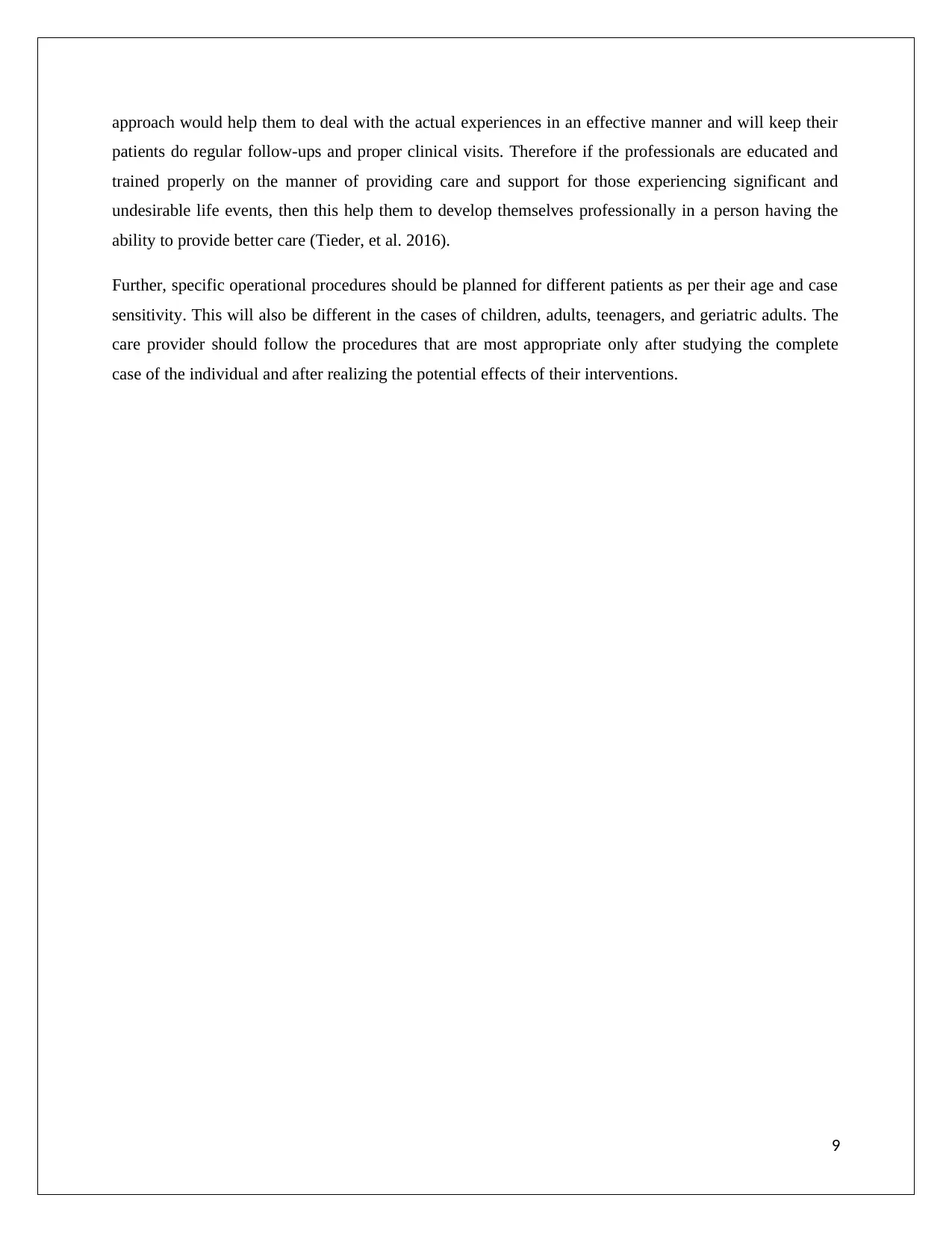
approach would help them to deal with the actual experiences in an effective manner and will keep their
patients do regular follow-ups and proper clinical visits. Therefore if the professionals are educated and
trained properly on the manner of providing care and support for those experiencing significant and
undesirable life events, then this help them to develop themselves professionally in a person having the
ability to provide better care (Tieder, et al. 2016).
Further, specific operational procedures should be planned for different patients as per their age and case
sensitivity. This will also be different in the cases of children, adults, teenagers, and geriatric adults. The
care provider should follow the procedures that are most appropriate only after studying the complete
case of the individual and after realizing the potential effects of their interventions.
9
patients do regular follow-ups and proper clinical visits. Therefore if the professionals are educated and
trained properly on the manner of providing care and support for those experiencing significant and
undesirable life events, then this help them to develop themselves professionally in a person having the
ability to provide better care (Tieder, et al. 2016).
Further, specific operational procedures should be planned for different patients as per their age and case
sensitivity. This will also be different in the cases of children, adults, teenagers, and geriatric adults. The
care provider should follow the procedures that are most appropriate only after studying the complete
case of the individual and after realizing the potential effects of their interventions.
9
⊘ This is a preview!⊘
Do you want full access?
Subscribe today to unlock all pages.

Trusted by 1+ million students worldwide
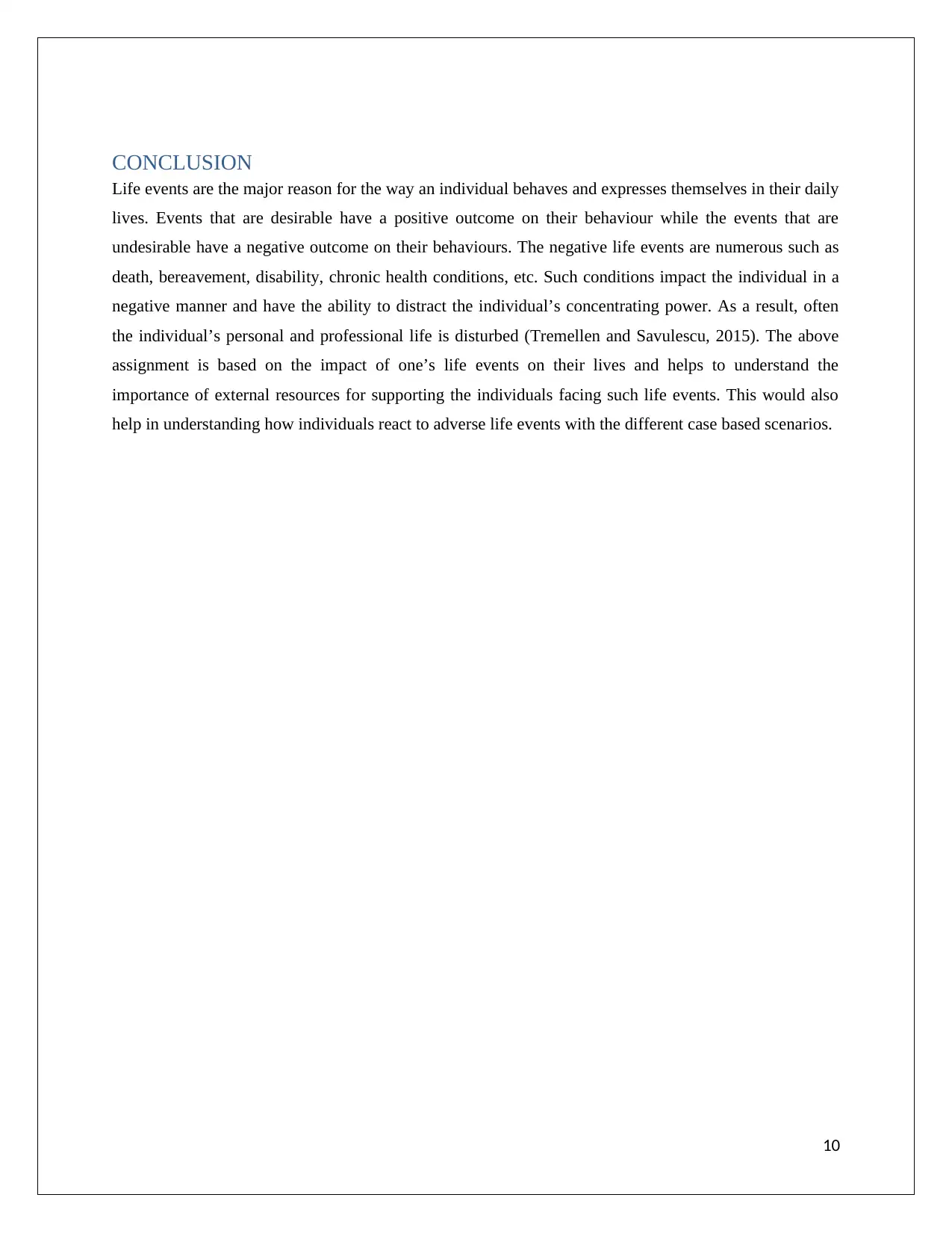
CONCLUSION
Life events are the major reason for the way an individual behaves and expresses themselves in their daily
lives. Events that are desirable have a positive outcome on their behaviour while the events that are
undesirable have a negative outcome on their behaviours. The negative life events are numerous such as
death, bereavement, disability, chronic health conditions, etc. Such conditions impact the individual in a
negative manner and have the ability to distract the individual’s concentrating power. As a result, often
the individual’s personal and professional life is disturbed (Tremellen and Savulescu, 2015). The above
assignment is based on the impact of one’s life events on their lives and helps to understand the
importance of external resources for supporting the individuals facing such life events. This would also
help in understanding how individuals react to adverse life events with the different case based scenarios.
10
Life events are the major reason for the way an individual behaves and expresses themselves in their daily
lives. Events that are desirable have a positive outcome on their behaviour while the events that are
undesirable have a negative outcome on their behaviours. The negative life events are numerous such as
death, bereavement, disability, chronic health conditions, etc. Such conditions impact the individual in a
negative manner and have the ability to distract the individual’s concentrating power. As a result, often
the individual’s personal and professional life is disturbed (Tremellen and Savulescu, 2015). The above
assignment is based on the impact of one’s life events on their lives and helps to understand the
importance of external resources for supporting the individuals facing such life events. This would also
help in understanding how individuals react to adverse life events with the different case based scenarios.
10
Paraphrase This Document
Need a fresh take? Get an instant paraphrase of this document with our AI Paraphraser
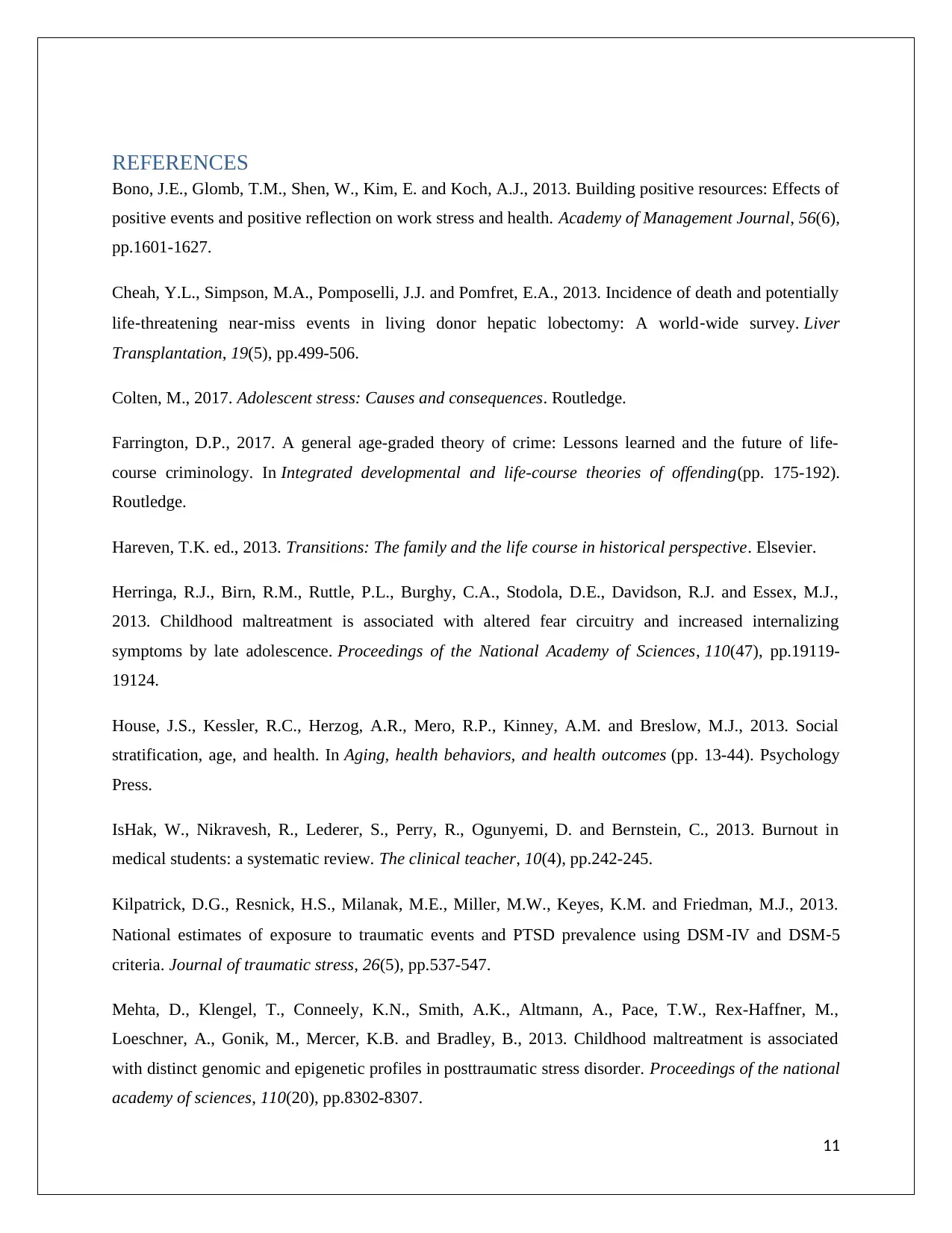
REFERENCES
Bono, J.E., Glomb, T.M., Shen, W., Kim, E. and Koch, A.J., 2013. Building positive resources: Effects of
positive events and positive reflection on work stress and health. Academy of Management Journal, 56(6),
pp.1601-1627.
Cheah, Y.L., Simpson, M.A., Pomposelli, J.J. and Pomfret, E.A., 2013. Incidence of death and potentially
life‐threatening near‐miss events in living donor hepatic lobectomy: A world‐wide survey. Liver
Transplantation, 19(5), pp.499-506.
Colten, M., 2017. Adolescent stress: Causes and consequences. Routledge.
Farrington, D.P., 2017. A general age-graded theory of crime: Lessons learned and the future of life-
course criminology. In Integrated developmental and life-course theories of offending(pp. 175-192).
Routledge.
Hareven, T.K. ed., 2013. Transitions: The family and the life course in historical perspective. Elsevier.
Herringa, R.J., Birn, R.M., Ruttle, P.L., Burghy, C.A., Stodola, D.E., Davidson, R.J. and Essex, M.J.,
2013. Childhood maltreatment is associated with altered fear circuitry and increased internalizing
symptoms by late adolescence. Proceedings of the National Academy of Sciences, 110(47), pp.19119-
19124.
House, J.S., Kessler, R.C., Herzog, A.R., Mero, R.P., Kinney, A.M. and Breslow, M.J., 2013. Social
stratification, age, and health. In Aging, health behaviors, and health outcomes (pp. 13-44). Psychology
Press.
IsHak, W., Nikravesh, R., Lederer, S., Perry, R., Ogunyemi, D. and Bernstein, C., 2013. Burnout in
medical students: a systematic review. The clinical teacher, 10(4), pp.242-245.
Kilpatrick, D.G., Resnick, H.S., Milanak, M.E., Miller, M.W., Keyes, K.M. and Friedman, M.J., 2013.
National estimates of exposure to traumatic events and PTSD prevalence using DSM ‐IV and DSM‐5
criteria. Journal of traumatic stress, 26(5), pp.537-547.
Mehta, D., Klengel, T., Conneely, K.N., Smith, A.K., Altmann, A., Pace, T.W., Rex-Haffner, M.,
Loeschner, A., Gonik, M., Mercer, K.B. and Bradley, B., 2013. Childhood maltreatment is associated
with distinct genomic and epigenetic profiles in posttraumatic stress disorder. Proceedings of the national
academy of sciences, 110(20), pp.8302-8307.
11
Bono, J.E., Glomb, T.M., Shen, W., Kim, E. and Koch, A.J., 2013. Building positive resources: Effects of
positive events and positive reflection on work stress and health. Academy of Management Journal, 56(6),
pp.1601-1627.
Cheah, Y.L., Simpson, M.A., Pomposelli, J.J. and Pomfret, E.A., 2013. Incidence of death and potentially
life‐threatening near‐miss events in living donor hepatic lobectomy: A world‐wide survey. Liver
Transplantation, 19(5), pp.499-506.
Colten, M., 2017. Adolescent stress: Causes and consequences. Routledge.
Farrington, D.P., 2017. A general age-graded theory of crime: Lessons learned and the future of life-
course criminology. In Integrated developmental and life-course theories of offending(pp. 175-192).
Routledge.
Hareven, T.K. ed., 2013. Transitions: The family and the life course in historical perspective. Elsevier.
Herringa, R.J., Birn, R.M., Ruttle, P.L., Burghy, C.A., Stodola, D.E., Davidson, R.J. and Essex, M.J.,
2013. Childhood maltreatment is associated with altered fear circuitry and increased internalizing
symptoms by late adolescence. Proceedings of the National Academy of Sciences, 110(47), pp.19119-
19124.
House, J.S., Kessler, R.C., Herzog, A.R., Mero, R.P., Kinney, A.M. and Breslow, M.J., 2013. Social
stratification, age, and health. In Aging, health behaviors, and health outcomes (pp. 13-44). Psychology
Press.
IsHak, W., Nikravesh, R., Lederer, S., Perry, R., Ogunyemi, D. and Bernstein, C., 2013. Burnout in
medical students: a systematic review. The clinical teacher, 10(4), pp.242-245.
Kilpatrick, D.G., Resnick, H.S., Milanak, M.E., Miller, M.W., Keyes, K.M. and Friedman, M.J., 2013.
National estimates of exposure to traumatic events and PTSD prevalence using DSM ‐IV and DSM‐5
criteria. Journal of traumatic stress, 26(5), pp.537-547.
Mehta, D., Klengel, T., Conneely, K.N., Smith, A.K., Altmann, A., Pace, T.W., Rex-Haffner, M.,
Loeschner, A., Gonik, M., Mercer, K.B. and Bradley, B., 2013. Childhood maltreatment is associated
with distinct genomic and epigenetic profiles in posttraumatic stress disorder. Proceedings of the national
academy of sciences, 110(20), pp.8302-8307.
11
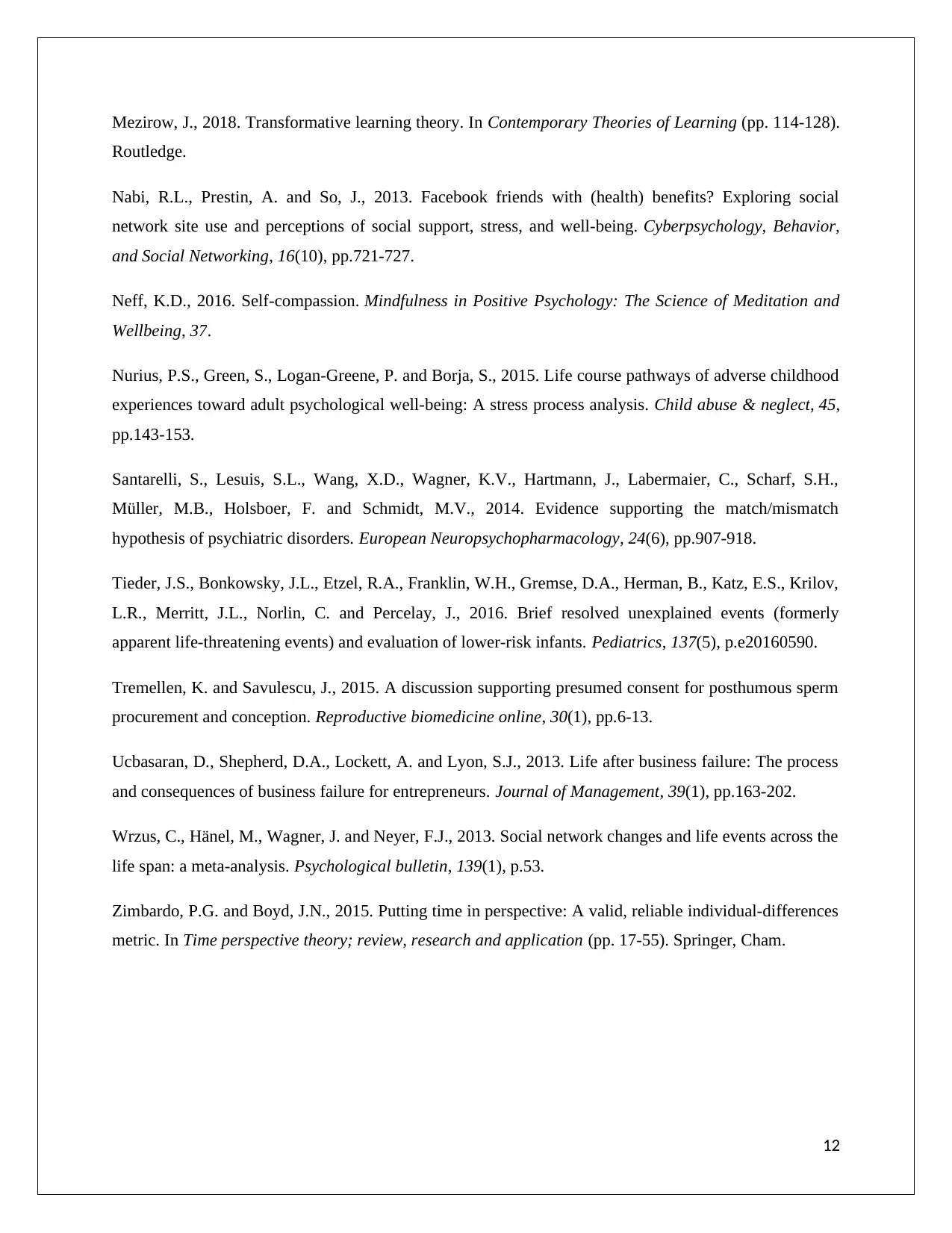
Mezirow, J., 2018. Transformative learning theory. In Contemporary Theories of Learning (pp. 114-128).
Routledge.
Nabi, R.L., Prestin, A. and So, J., 2013. Facebook friends with (health) benefits? Exploring social
network site use and perceptions of social support, stress, and well-being. Cyberpsychology, Behavior,
and Social Networking, 16(10), pp.721-727.
Neff, K.D., 2016. Self-compassion. Mindfulness in Positive Psychology: The Science of Meditation and
Wellbeing, 37.
Nurius, P.S., Green, S., Logan-Greene, P. and Borja, S., 2015. Life course pathways of adverse childhood
experiences toward adult psychological well-being: A stress process analysis. Child abuse & neglect, 45,
pp.143-153.
Santarelli, S., Lesuis, S.L., Wang, X.D., Wagner, K.V., Hartmann, J., Labermaier, C., Scharf, S.H.,
Müller, M.B., Holsboer, F. and Schmidt, M.V., 2014. Evidence supporting the match/mismatch
hypothesis of psychiatric disorders. European Neuropsychopharmacology, 24(6), pp.907-918.
Tieder, J.S., Bonkowsky, J.L., Etzel, R.A., Franklin, W.H., Gremse, D.A., Herman, B., Katz, E.S., Krilov,
L.R., Merritt, J.L., Norlin, C. and Percelay, J., 2016. Brief resolved unexplained events (formerly
apparent life-threatening events) and evaluation of lower-risk infants. Pediatrics, 137(5), p.e20160590.
Tremellen, K. and Savulescu, J., 2015. A discussion supporting presumed consent for posthumous sperm
procurement and conception. Reproductive biomedicine online, 30(1), pp.6-13.
Ucbasaran, D., Shepherd, D.A., Lockett, A. and Lyon, S.J., 2013. Life after business failure: The process
and consequences of business failure for entrepreneurs. Journal of Management, 39(1), pp.163-202.
Wrzus, C., Hänel, M., Wagner, J. and Neyer, F.J., 2013. Social network changes and life events across the
life span: a meta-analysis. Psychological bulletin, 139(1), p.53.
Zimbardo, P.G. and Boyd, J.N., 2015. Putting time in perspective: A valid, reliable individual-differences
metric. In Time perspective theory; review, research and application (pp. 17-55). Springer, Cham.
12
Routledge.
Nabi, R.L., Prestin, A. and So, J., 2013. Facebook friends with (health) benefits? Exploring social
network site use and perceptions of social support, stress, and well-being. Cyberpsychology, Behavior,
and Social Networking, 16(10), pp.721-727.
Neff, K.D., 2016. Self-compassion. Mindfulness in Positive Psychology: The Science of Meditation and
Wellbeing, 37.
Nurius, P.S., Green, S., Logan-Greene, P. and Borja, S., 2015. Life course pathways of adverse childhood
experiences toward adult psychological well-being: A stress process analysis. Child abuse & neglect, 45,
pp.143-153.
Santarelli, S., Lesuis, S.L., Wang, X.D., Wagner, K.V., Hartmann, J., Labermaier, C., Scharf, S.H.,
Müller, M.B., Holsboer, F. and Schmidt, M.V., 2014. Evidence supporting the match/mismatch
hypothesis of psychiatric disorders. European Neuropsychopharmacology, 24(6), pp.907-918.
Tieder, J.S., Bonkowsky, J.L., Etzel, R.A., Franklin, W.H., Gremse, D.A., Herman, B., Katz, E.S., Krilov,
L.R., Merritt, J.L., Norlin, C. and Percelay, J., 2016. Brief resolved unexplained events (formerly
apparent life-threatening events) and evaluation of lower-risk infants. Pediatrics, 137(5), p.e20160590.
Tremellen, K. and Savulescu, J., 2015. A discussion supporting presumed consent for posthumous sperm
procurement and conception. Reproductive biomedicine online, 30(1), pp.6-13.
Ucbasaran, D., Shepherd, D.A., Lockett, A. and Lyon, S.J., 2013. Life after business failure: The process
and consequences of business failure for entrepreneurs. Journal of Management, 39(1), pp.163-202.
Wrzus, C., Hänel, M., Wagner, J. and Neyer, F.J., 2013. Social network changes and life events across the
life span: a meta-analysis. Psychological bulletin, 139(1), p.53.
Zimbardo, P.G. and Boyd, J.N., 2015. Putting time in perspective: A valid, reliable individual-differences
metric. In Time perspective theory; review, research and application (pp. 17-55). Springer, Cham.
12
⊘ This is a preview!⊘
Do you want full access?
Subscribe today to unlock all pages.

Trusted by 1+ million students worldwide
1 out of 12
Related Documents
Your All-in-One AI-Powered Toolkit for Academic Success.
+13062052269
info@desklib.com
Available 24*7 on WhatsApp / Email
![[object Object]](/_next/static/media/star-bottom.7253800d.svg)
Unlock your academic potential
Copyright © 2020–2025 A2Z Services. All Rights Reserved. Developed and managed by ZUCOL.




